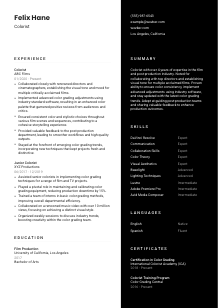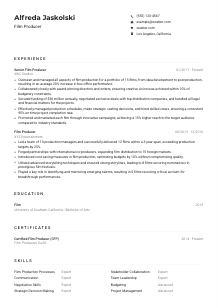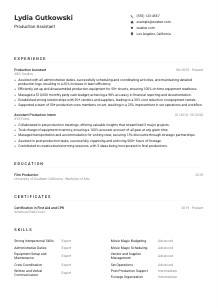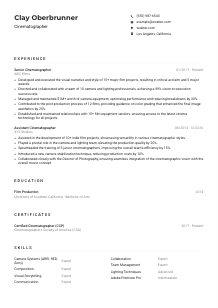Colorist Resume Example
Painting palettes, but your resume feels grayscale? Dive into this Colorist resume example, brushed with Wozber free resume builder. Discover how effortlessly you can blend your chromatic talents with job specifications, painting a career canvas that radiates with vibrancy and hue!
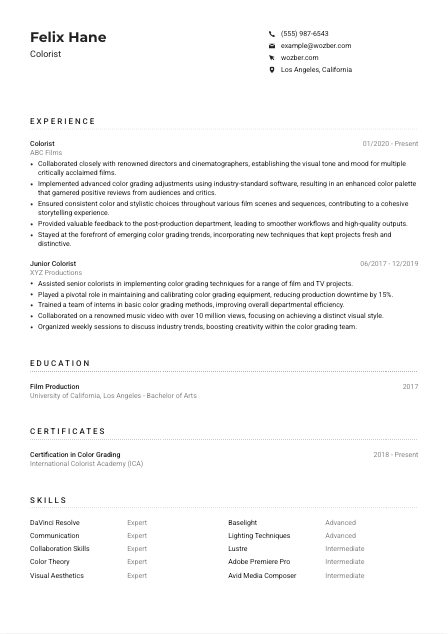
How to write a Colorist Resume?
Hello there, aspiring Colorist! If you're passionate about color grading and eager to make your mark in the film or post-production industry, your resume is your ticket to unlocking the door to your dream job. But not just any resume – a carefully crafted, ATS-compliant resume that mirrors the heart and soul of color grading.
Using the Wozber free resume builder, let's dive into creating a resume that doesn't just meet the job requirements but sings your unique vision and expertise in color. Let's turn the monochromatic into the magnificent together!
Personal Details
Your resume's personal details are like the opening credits to a movie – setting the stage for what's to come. Let's ensure your 'credits' captivate from the get-go, perfectly aligned with the Colorist role you're eyeing.
1. Lights, Camera, Action on Your Name
Think of your name as the title of your personal feature film. It should grab attention. Opt for a clear, legible font and size it just a bit larger than the rest of your text. This is your marquee, after all.
2. Role Identification
Directly beneath your name, place the role you're applying for – in this case, "Colorist". This signals to the hiring manager and the ATS scanner that you're specifically tailored for the position, right from the top.
3. Communication Channels
Ensure your contact information is pristine. Double-check your phone number for accuracy, and use a professional email format. Given the highly collaborative nature of a Colorist's role, showcasing impeccable communication starts here.
4. Setting the Scene
Mentioning "Los Angeles, California" aligns with the job's location requirement. It's a small detail that makes a significant difference, indicating you're ready to roll without relocation delays.
5. Display Your Portfolio
If you have a professional website or portfolio showcasing your color grading projects, include it. This adds depth to your application, allowing employers to visualize your expertise beyond the resume.
Takeaway
The opening act of your resume sets the tone. Make it professional, aligned with the Colorist role, and geared towards making a vibrant first impression. Remember, this is your promotional poster – make it count!





Experience
The experience section is where your resume starts to show its true colors. Here's how to paint your professional journey in hues that resonate deeply with the Colorist role.
- Collaborated closely with renowned directors and cinematographers, establishing the visual tone and mood for multiple critically acclaimed films.
- Implemented advanced color grading adjustments using industry‑standard software, resulting in an enhanced color palette that garnered positive reviews from audiences and critics.
- Ensured consistent color and stylistic choices throughout various film scenes and sequences, contributing to a cohesive storytelling experience.
- Provided valuable feedback to the post‑production department, leading to smoother workflows and high‑quality outputs.
- Stayed at the forefront of emerging color grading trends, incorporating new techniques that kept projects fresh and distinctive.
- Assisted senior colorists in implementing color grading techniques for a range of film and TV projects.
- Played a pivotal role in maintaining and calibrating color grading equipment, reducing production downtime by 15%.
- Trained a team of interns in basic color grading methods, improving overall departmental efficiency.
- Collaborated on a renowned music video with over 10 million views, focusing on achieving a distinct visual style.
- Organized weekly sessions to discuss industry trends, boosting creativity within the color grading team.
1. Decode the Script
Carefully dissect the job requirements. For our Colorist example, highlighting experience with "industry-standard color grading software" and "collaboration with directors" mirrors key requirements.
2. Building Your Storyboard
List your experience in reverse-chronological order. Start with your most recent role, ensuring you include the job title, company name, and your tenure there. This forms the backbone of your professional narrative.
3. Painting the Details
For each role, craft bullet points that speak directly to the job listing. Use action verbs and detail how you "collaborated with directors to establish visual tone", or "implemented advanced color grading", tying your achievements back to the requirements.
4. Adding Depth with Numbers
Whenever possible, quantify your contributions. Maybe you enhanced the color palette for a project viewed by millions or led a workshop that improved departmental efficiency by a significant percentage. Numbers draw the eye and provide scale.
5. Curating Your Gallery
Focus on the experiences most relevant to the role of a Colorist. If you've also dabbled in editing or cinematography, frame these experiences in a way that complements your color grading expertise.
Takeaway
Your experience section is a gallery of your professional achievements. Craft it with the precision of a color palette selection, ensuring each bullet point contributes to a cohesive and compelling narrative of your Colorist capabilities.
Education
While the spotlight often shines on experience, your education offers a glimpse into your foundational knowledge. Here's how to ensure it supports your candidacy for the Colorist role effectively.
1. Color Grading Curriculum
When no explicit educational requirements are mentioned, a degree in Film Production or a related field, as in our example, showcases a broad foundation. Highlight this alignment.
2. Painting the Basics
Keep this section clear and concise but ensure it reflects your readiness for the role. List your degree, the institution, and your graduation year in a no-frills format.
3. Accentuating Relevant Tones
If you've taken specific courses in color grading, color theory, or anything closely related to the demands of a Colorist, make sure to paint those details into your educational background.
4. Extra Layers of Detail
Include academic honors, relevant clubs, or projects if they add depth to your Colorist profile, especially for early-career professionals. These can add rich textures to the tapestry of your education section.
5. Ongoing Masterclasses
If your education in the field is ongoing or you've recently updated your skills through workshops, including these can demonstrate a commitment to keeping your palette fresh and relevant.
Takeaway
Your education section is the undercoat to your professional achievements. Optimized correctly, it complements your experience, highlighting a robust foundation in film production and a deep understanding of color – essential for the aspiring Colorist.
Certificates
In the ever-evolving field of color grading, certifications can add credibility and a touch of brilliance to your resume. Here's how to elegantly frame them for the Colorist position.
1. Pinpointing Prerequisites
First, revisit the job description. Highlight certifications you possess that align with preferred qualifications, such as "Certification in Color Grading" and "Colorist Training Program" from our example.
2. Selecting the Brightest Colors
Focus on relevant certifications that directly enhance your profile as a Colorist. It's about quality, not quantity. Highlight those that demonstrate mastery of tools or advanced color grading techniques.
3. Framing with Dates
Include the date of certification where applicable, especially if recent. This shows you're up-to-date with the latest trends and technologies in color grading, an important trait for a dynamic industry.
4. Continual Education Palette
Stay committed to ongoing learning. Regularly update your certifications and seek out new opportunities to learn and grow in the field. This commitment to excellence can set you apart from other candidates.
Takeaway
Your certifications section is a highlight reel of your specialized training and competencies. Spotlight the most relevant and recent achievements to show you not only meet but exceed the technical requirements of a Colorist.
Skills
The skills section is your chance to showcase your professional toolkit. Let's tune it to resonate beautifully with the role of a Colorist, blending hard and soft skills to create the perfect composition.
1. Mixing the Color Palette
Start by identifying key skills from the job description, like "mastery of industry-standard color grading software" and "strong understanding of color theory". These are your primary hues.
2. Highlighting Key Abilities
Showcase your mastery in DaVinci Resolve, your advanced skills in Baselight, and your strong foundation in color theory. Don't forget soft skills like "excellent communication and collaboration", essential for working in creative teams.
3. Filtering Out the Excess
While it's tempting to list all your skills, focus on those most relevant to a Colorist. Aim for a mix that balances technical prowess with soft skills, showing you're not only skilled but a team player.
Takeaway
Your skills section is the color wheel of your resume. Carefully curated, it should reflect a balance of technical skills and collaborative abilities, all crucial for a Colorist. Let this section be a testament to your expertise and your readiness to contribute meaningfully to creative projects.
Languages
In the global film industry, being multilingual can be a distinct advantage. Let's script the languages section to illustrate your proficiency and how it enhances your capabilities as a Colorist.
1. Verifying Language Requirements
Start by noting the specific language requirements mentioned in the job listing, like "strong skills in both verbal and written English are essential." These are your primary dialects.
2. Leading with Required Languages
English is your starting point; showcase your proficiency here. If you're a native speaker or fluent, make that clear. This assures hiring managers of your communication prowess.
3. Adding Additional Tongues
If you speak other languages, list them too. For a Colorist, being fluent in additional languages can signify your ability to collaborate on international projects or work within diverse teams.
4. Rating Your Fluency
Be honest and clear about your language proficiency, using terms like 'native', 'fluent', 'intermediate', or 'basic'. This transparency ensures realistic expectations and showcases your global communication skills.
5. Contextualizing Within the Role
Consider the broader scope of your role and the industry. Your ability to communicate in multiple languages may not be a primary requirement, but it highlights your versatility and could open doors to opportunities on global projects.
Takeaway
Your linguistic skills are more than just a list on a resume; they reflect your ability to navigate diverse cultural and professional landscapes. For a Colorist, this can translate to a broader understanding of global aesthetics and enhanced collaboration on international projects. Celebrate your multilingual talents as part of your unique professional palette.
Summary
The summary section is your chance to distill your professional essence into a few compelling lines. Here's how to craft a Colorist's summary that captures the imagination and attention of the hiring manager.
1. Understanding the Plot
Begin by revisiting the job description to grasp the desired qualifications and responsibilities. This understanding will serve as your guide, helping you to emphasize your alignment with the role.
2. Setting the Scene
Introduce yourself with confidence. Present your experience and passion for color grading, highlighting your proficiency with specific software and your grasp of visual aesthetics, as the job requires.
3. Highlighting Your Masterpieces
Point to standout moments in your career where you've collaborated on acclaimed projects or introduced innovative grading techniques. This tells a story of continual progress and passion for your craft.
4. Keeping It Vibrant Yet Concise
Aim for a summary that's brief yet captures the essence of your professional journey and aspirations. It's your trailer – make it intriguing, leaving the hiring manager eager to discover more.
Takeaway
Your summary is the opening scene of your career narrative. Craft it to spark interest, blending your technical skills, collaborative successes, and vision for color in storytelling. This is your moment to shine; make every word count toward portraying you as the ideal candidate for the Colorist role.
Launching Your Colorist Journey
Congratulations, you've now crafted a resume that not only highlights your qualifications but also resonates with the unique requirements of a Colorist role. By using the Wozber free resume builder, you've optimized your resume for both human eyes and ATS scanners, ensuring your application stands out. Remember, your resume is a living document that reflects your ongoing professional journey. Keep it updated with new skills, experiences, and achievements as your career in color grading evolves.
The canvas of your career is vast, and with every project, you add more depth and hue to your story. Go forth and illuminate the industry with your vision!

- Minimum of 3 years of professional experience as a Colorist, preferably in the film or post-production industry.
- Mastery of industry-standard color grading software such as DaVinci Resolve, Baselight, or Lustre.
- Strong understanding of color theory, lighting, and visual aesthetics.
- Excellent communication and collaboration skills to work closely with directors, cinematographers, and post-production teams.
- Certification in Color Grading or Colorist Training programs is a plus.
- Strong skills in both verbal and written English are essential.
- Must be located in Los Angeles, California.
- Collaborate with directors and cinematographers to establish the visual tone and mood of a film or project.
- Implement color grading adjustments using software tools to enhance or alter the color palette and atmosphere of the footage.
- Ensure consistent color and stylistic choices across all scenes and sequences.
- Provide feedback and guidance to junior colorists or editing teams in post-production department.
- Stay updated with the latest industry trends, techniques, and technologies in color grading.







